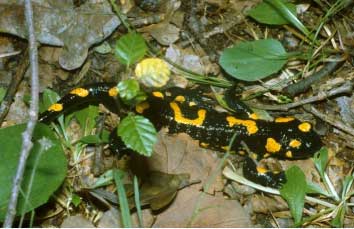
A particularly attractive member of the newt family is the alpine newt (Triturus alpestris) which, during the mating season, displays a yellow striped crest along its back and a bright orange belly. The black salamander (Salamandra atra) lives in the high mountains. It is a rare species with viviparous behaviour – in other words the babies are born like small adults.
The Morphology of Amphibians
The members of the amphibian class are vertebrates with damp, bare skin which is often lumpy and wrinkled. The term amphibian means double life and indicates that these animals can live both in water and on land. The reproduction, development of the eggs and larva state usually with breathing through gills are all phases which take place in water, while adult life can take place entirely on land with lung breathing, helped, or sometimes substituted, by breathing through the skin or pharyngeal hole.
Amphibians are heterothermal, that is they have a body temperature the same as their environment. Their skin is covered with warts containing many grainy glands which secrete irritating, poisonous mucous that kills bacteria. In some species like the fire salamander and the yellow-bellied toad their bright colours warn that their flesh is poisonous and inedible.
Amphibians are usually oviparous except in some cases which are ovoviviparous. Their eggs are sometimes laid in a gelatinous substance surrounded by a membrane. Their development involves a metamorphosis with the growth of limbs, loss of external gills and then in some cases the tail.
The local amphibians belong to 2 orders: the Anuri (toads and frogs) without tails, squat and with long back legs for jumping, while the Urodeli (newts and salamanders) have a tail, a long body and move slowly on land.
This group of animals is threatened with extinction because in their early stages of growth they are vulnerable, depending on water being available, if only temporarily.